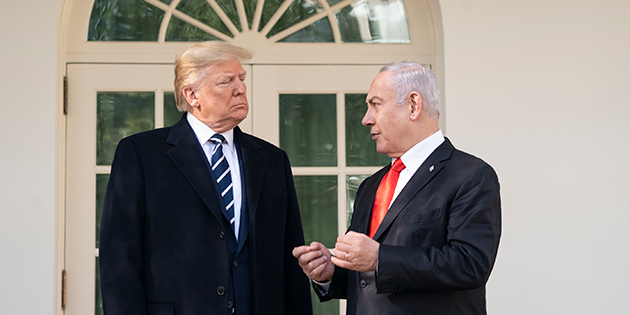
This article was originally published by the United States Institute of Peace (USIP) on 29 January 2020.
Without a basis for negotiation around which both sides feel they can come to the table, peace will remain elusive.
Yesterday, at an East Room gathering, President Trump, alongside Israeli Prime Minister Benjamin Netanyahu, unveiled his administration’s plan to address the Israeli-Palestinian conflict. As promised at the outset of his remarks, the approach represents a vision “fundamentally different from past proposals.” The event itself—with the plan unveiled by U.S. and Israeli leadership—presented a visual that underscored this difference, and the challenge this plan faces if it is to chart a course to peace.
With Palestinians absent from the room, President Trump praised Israel’s prime minister for taking a bold step forward, rightly acknowledging that this is the first time Israel has agreed to the presentation of a map showing Israeli territorial compromises. To be sure, territorial compromise is far from a consensus issue in Israel—within hours of the plan’s release, the country’s defense minister, Naftali Bennett, rejected the proposal noting he and his political party would not agree to transfer a “centimeter of land to the Arabs.” But such intra-Israeli disagreement will not be forced to a head any time soon. The U.S. administration gave its blessing to Israel to immediately begin annexing territory that it envisions to be part of the State of Israel. At the same time, it stipulated that the Palestinians have four years to meet a slate of preconditions for achieving its potential state.
Moreover, the envisioned future-state of Palestine is one that falls far short of Palestinian aspirations. This fact was acknowledged by a senior U.S. administration official prior to the plan’s release. Speaking to Israel Hayom, this unnamed official reacted to right-wing concerns that a plan would lead to the establishment of a Palestinian state by stating that if such opponents were to “… look at the dictionary, [they’ll] understand this isn’t the definition of a state. That is not what the plan allows, and so the resistance from the [r]ight … is a mistake.”
That the Palestinians seem to agree with this interpretation of what is on offer for them challenges the ability for the plan, in current form, to serve as a vehicle for ending the conflict. Without a basis for negotiation around which both sides feel they can come to the table, and from which both sides assess they have something meaningful to gain, peace will remain elusive. Prime Minister Netanyahu spoke of his own willingness to “negotiate peace with the Palestinians on the basis of [the Trump administration] peace plan.” However, the plan already allows for Israel to achieve most of its aspirations on longstanding core issues of the conflict, leaving ambiguous the issues on which the Palestinians would have room to negotiate.
Yet the fact that the plan does not readily augur a path to peace, does not diminish its significance. Some U.S. senators denounced the plan as a non-starter, suggesting a future scenario in which a different president might distance herself or himself from this approach. But a test of that proposition is one to five years away. In the meantime, Israel can begin annexation in accordance with a map from which any future Israeli leader would be hard pressed, domestically, to retreat. In other words, the plan may not chart a clear and direct course to peace, but it posits a new starting point for any future negotiations between the parties.
What remains to be seen is what additional influence, disincentives and incentives are brought to bear on the parties by U.S. allies in reaction to the plan, and in the interest of working with the U.S. to spur progress and prevent deterioration. Reactions from key international community stakeholders, including Arab and European states, have been mixed. They have run a narrow gamut from cautious welcome of proactive U.S. efforts to address the conflict, to calls for the parties to resume direct negotiations, caution over unilateral moves, and reaffirmation of a commitment to a negotiated and mutually acceptable solution. The Arab League, traditionally a body offering rhetorical backing for the Palestinians, will meet later this weekend and a rare joint meeting of the leadership of rival Palestinian factions is to take place in Ramallah next Tuesday. Netanyahu has raised the possibility he might bring a vote for annexation before his cabinet meeting as early as next week.
As these events unfold, the temperature on the ground among Israeli, Palestinian and regional publics, and at the official level, will become increasingly measurable. So will the extent to which yesterday’s “Vision to Improve the Lives of the Palestinian and Israeli People” could impact the future trajectory of the conflict and efforts to resolve it.
About the Author
Lucy Kurtzer-Ellenbogen is the director of the Israeli-Palestinian conflict program at the United States Institute of Peace (USIP).
For more information on issues and events that shape our world, please visit the CSS website.

